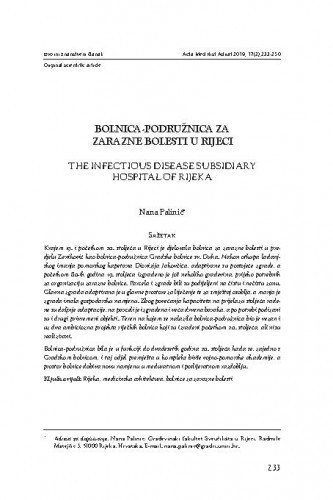Krajem 19. i početkom 20. stoljeća u Rijeci je djelovala bolnica za zarazne bolesti u predjelu Zeniković kao bolnica-podružnica Gradske bolnice sv. Duha. Nakon otkupa ladanjskog imanja pomorskog kapetana Dionizija Jakovčića, adaptirane su postojeće zgrade, a početkom 80-ih godina 19. stoljeća izgrađeno je još nekoliko građevina, prijeko potrebnih za organizaciju zarazne bolnice. Parcela i zgrade bili su podijeljeni na čistu i nečistu zonu. Glavna zgrada adaptirana je u glavne prostore za liječenje te za smještaj osoblja, a manja je zgrada imala gospodarsku namjenu. Zbog povećanja kapaciteta na prijelazu stoljeća rađene su daljnje adaptacije, na parceli je izgrađena i veća drvena baraka, a po potrebi podizani su i drugi privremeni objekti. Teren na kojem se nalazila bolnica-podružnica bio je vezan i uz dva ambiciozna projekta riječkih bolnica koji su izrađeni početkom 20. stoljeća, ali nisu realizirani. Bolnica-podružnica bila je u funkciji do dvadesetih godina 20. stoljeća kada se, zajedno s Gradskom bolnicom, i taj odjel premješta u kompleks bivše vojno-pomorske akademije, a prostor bolnice dobiva novu namjenu u međuratnom i poslijeratnom razdoblju.; In the late 19th and early 20th centuries, a hospital for infectious diseases in the Zeniković area was operating in Rijeka as a hospital - subsidiary of the City Hospital of St. Spirit. After purchasing the property of the naval captain Dionysius Jakovčić, the existing buildings were adapted and several other buildings, necessary for the organization of an infectious hospital, were constructed in the early eighties of the 19th century. The terrain and buildings were divided into clean and unclean areas. The main building was adapted to the main facilities for treatment and accommodation, while the smaller building was used for economic purposes. Due to the increase of the capacity at the turn of the century, further adaptations were made, larger wooden barracks and other temporary facilities were also constructed. The terrain of the hospital was linked to two ambitious projects of the hospitals in Rijeka, which were created at the beginning of the 20th century but were not realized. The hospital operated until the twenties of the 20th century when this department together with the City Hospital was moved to the former Naval Academy complex, while the hospital area was given a new purpose in the interwar and postwar periods.
Sažetak

 Acta medico-historica Adriatica : 17,2(2019) / glavni urednik, editor-in-chief Igor Eterović.
Acta medico-historica Adriatica : 17,2(2019) / glavni urednik, editor-in-chief Igor Eterović.